Description: This biennial wildflower forms a low rosette of leaves about 8-12" across during the first year. During the second year, it bolts and becomes 2-7' tall. Usually, this wildflower is unbranched, although sometimes ascending lateral branches develop along the upper one-third of a large plant. The central stem (and any lateral stems) is rather stout, terete, and light green to pale purple; it is usually hairy along the lower half of its length, becoming hairless and slightly glaucous along the upper half. The alternate leaves are up to 6" long and 2" across, becoming gradually smaller as they ascend the stem; they are pinnatifid with pointed irregular lobes and dentate along their margins. The upper surfaces of these leaves are medium green and often sparsely hairy; their lower surfaces are pale green and hairy, particularly along the midribs.
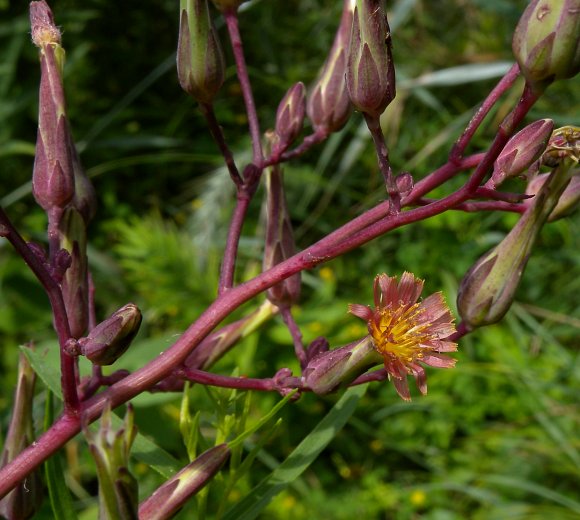
The basal leaves are similar to the alternate leaves, except they tend to be larger in size and more wide toward their tips (narrowly obovate to obovate). Young developing basal leaves are usually very hairy on both their upper and lower surfaces. The central stem (and any lateral stems) terminates in an elongated panicle of flowerheads about 6-12" long and 2-4" across. The branches of the panicle are light green to reddish purple, terete, and usually hairless. Each flowerhead is about 1/3" (8-10 mm.) across when fully open, consisting of 12-25 ray florets, no disk florets, and light green to purple floral bracts that are arranged in about 3 series around its base (involucre); this base is about 2/3–3/4" (15-20 mm.) long. The rays of the flowerhead are colored salmon to brick-red and their tips are truncate and finely toothed. The outer floral bracts are shorter than the inner floral bracts.
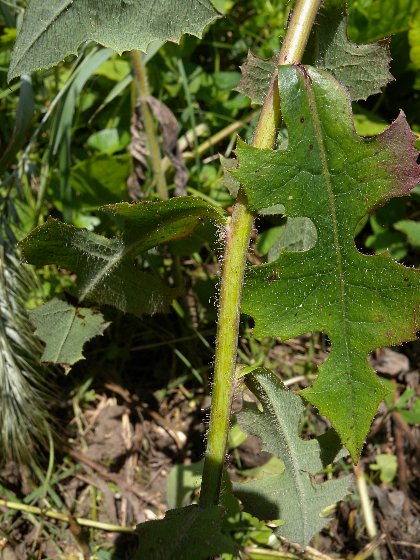
The blooming
period occurs from mid-summer to early fall and usually lasts about 3
weeks. Individual flowerheads last only a single day, blooming for only
a few hours on sunny days. After only a short period of time,
individual flowerheads are replaced by small black achenes with tufts
of white hair. Each achene is 4-5 mm. long, ellipsoid-oblanceoloid in
shape, and flattened; the tuft of white hairs is attached to the achene
by a slender white beak about 2.5–3.5 mm. long. These achenes are
distributed by the wind. The root system consists of a taproot. This
wildflower reproduces by reseeding itself.
Cultivation:
The preference is partial sun, mesic to dry conditions, and somewhat
acidic sandy or rocky soil. The size of individual plants is highly
variable, depending on moisture levels and soil fertility.
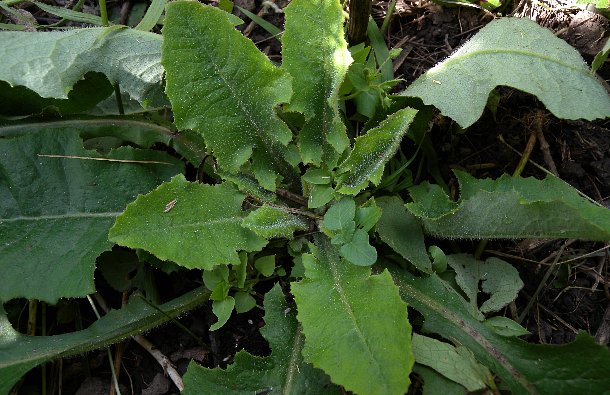
Range & Habitat: Red-Flowered Wild Lettuce is a rare native plant in Illinois and it is state-listed as 'endangered.' Thus far, this species has been collected from a single county in southern Illinois (see Distribution Map). Because this species can be confused with other Lactuca spp., it may occur in other areas of the state. Outside of Illinois, this species is also uncommon. Habitats include upland rocky woodlands, woodland openings, woodland borders, upland savannas, sandstone glades, pastures, and abandoned fields. These habitats also include sandy areas. Red-Flowered Wild Lettuce prefers some disturbance to reduce the abundance of woody vegetation.
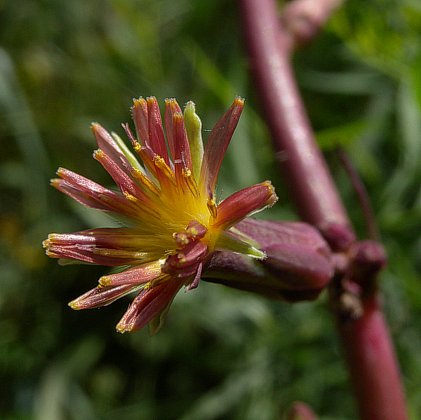
Faunal
Associations:
Little is known about floral-faunal relationships for this particular
species. The flowerheads are probably cross-pollinated by various bees
(medium- to small-sized), which offer nectar and pollen. In general,
the caterpillars of some moths feed on Lactuca spp.
(Wild Lettuce species), including Autographa precationis
(Common Looper Moth), Grammia virgo (Virgin Tiger
Moth), and Cucullia intermedia (Intermediate
Cucullia). The caterpillars of the last moth species feed on the
flowerheads. Other insect feeders include Thrips physapus
(Dandelion Thrips) and several aphid species: Hyperomyza
lactucae (Currant-Sowthistle Aphid), Nasonovia
ribisnigri (Currant-Lettuce Aphid), Pemphigus
bursarius (Lettuce Root Aphid), Prociphilus
erigeronensis (White Aster Root Aphid), Uroleucon
ambrosiae (Brown Ambrosia Aphid), Uroleucon
gravicorne (Aphid sp.), Uroleucon pseudambrosiae
(False Ambrosia Aphid), Uroleucon rudbeckiae
(Golden Glow Aphid), and Uroleucon sonchella
(Sowthistle Aphid). Among vertebrate animals, the Eastern Goldfinch
eats the seeds, while White-Tailed Deer occasionally graze on the
foliage of Lactuca spp.
Photographic Location:
The wildflower garden of the webmaster in Urbana, Illinois.
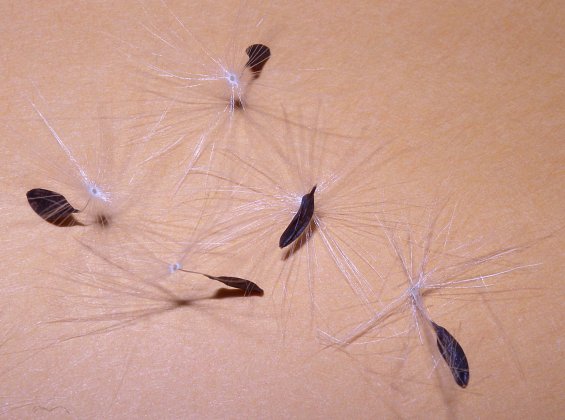
Comments: This unusual species has been sadly neglected from many wildflower field guides. Although it has an extensive range in the eastern half of the United States, Red-Flowered Wild Lettuce appears to be uncommon to rare in most areas. The preceding description applies to var. sanguinea, rather the typical variety. In other areas of its range, Lactuca hirsuta may have yellow flowerheads and the hairiness of its stems and leaves can be variable (from nearly hairless to very hairy). Red-Flowered Wild Lettuce can be easily confused with the more common Lactuca canadensis (Common Wild Lettuce), which is itself a rather variable species. Generally, Common Wild Lettuce has flowerheads that are pale yellow to dull orange, flowerheads with shorter bases (involucres) that are ½" or less, and shorter achenes (less than 4 mm. long). Common Wild Lettuce is usually completely glabrous (except for some hairs along the lower midribs of its leaves), and its upper stems and floral branches are usually less purple. Another species, Lactuca biennis (Tall Blue Lettuce), has light blue to cream-colored flowerheads and its achenes have shorter beaks and tufts of tawny or gray hair, rather than white hair. These different Lactuca spp. cannot be identified reliably unless the flowerheads or tufted achenes are available for examination. Another common name of Lactuca hirsuta is Hairy Wild Lettuce.